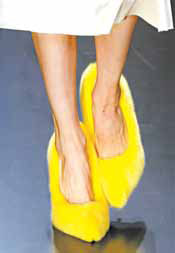Finding a comfort zone
Updated: 2013-02-17 08:37
(The New York Times)
|
|||||||
|
Women have been wearing fuzzy shoes out on the street. Pumps from the spring 2013 Celine show. Pierre Verdy, Via Agence France-Presse |

Relax, research tells us, for better productivity. Slow down, dress down take it easy. And we're listening, eager to fulfill our desire for creature comforts.
Chances are your classroom chair was not made for comfort. It was a rigid design of steel, sawdust and resin that was made for a student to sit up and work. But now everything must be ergonomic. The new chairs at Thomas Nelson High School in Kentucky allow students to face front or back. They are "human friendly" and "form to the body," Wes Bradley, the principal, told The Times. In Albuquerque, the nex+Gen Academy High School's chairs have wheels. Administrators say that the children seem more engaged in their flexible chairs.
But it's not only children getting comfortable. An odd, fuzzy trend has adult women wearing oversized furry slippers out of the house, some pairing them with business suits. The Wookie look may be linked to the designer Phoebe Philo, whose Celine show for spring 2013 featured fuzzy pumps, wrote The Times's Guy Trebay.
Fashion has a subversive tendency to "erode the lines between public and domestic life," he wrote. Lingerie worn as outerwear, pajamas on the street, Crocs and Adidas shower shoes "are examples of the ways a once sharp division between how we dress at home and present ourselves on the street has blurred, probably forever."
To Hamish Bowles of Vogue, "it's all about comfort." But Carlyne Cerf de Dudzeele, another Vogue editor, was surprised. "You cannot find something else to wear and be comfortable?"
There are other options. Adult-sized onesies, plush one-piece outfits meant for infants, have grown-ups retreating into toddlerhood. Hailing from Europe, onesies are embraced by stars like Justin Bieber and members of the band One Direction. A onesie from OnePiece of Norway ranges from $160 to $290. Meant as an anti-fashion statement, it may go as quickly as it came, because one person's comfort is another's pain.
In the office, there is no universal definition of comfort, especially when it comes to temperature, wrote Maggie Koerth-Baker in The Times Magazine. As air conditioners become more affordable, globalization has helped popularize a building code called Ashrae 55, which determines the ideal temperature for large buildings across the globe. But the standard is not culture-blind. "It's based on Fanger's Comfort Equation, a mathematical model developed in Denmark and the United States in the 1960s and '70s, which seeks to make a very specific worker comfortable: a man wearing a full business suit," wrote Ms. Koerth-Baker.
But what about wardrobe for office workers in hotter countries, where a dashiki is acceptable business attire? These workers may start to dress differently, making them less comfortable outside and at home, she wrote.
And what about women, who tend to wear thinner blouses, skirts and sandals when it's warm out? "But the building temperature is set for men, who are assumed to be wearing long-sleeved shirts and closed-toed shoes year-round," Susan Mazur-Stommen of the American Council for an Energy-Efficient Economy told The Magazine. "If everyone just dressed appropriately for the weather, we wouldn't have to heat or cool the building as much."
But what's appropriate if, as Ms. Koerth-Baker says, the definition of something as elemental as comfort is always changing?
Anita Patil
The New York Times
(China Daily 02/17/2013 page9)
